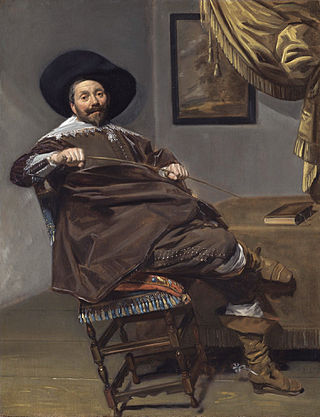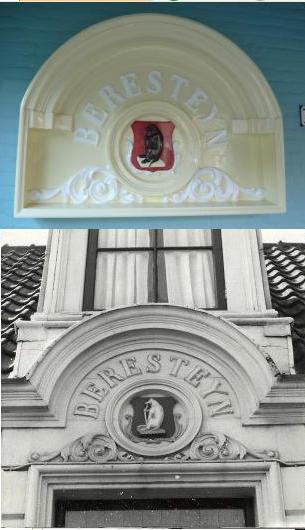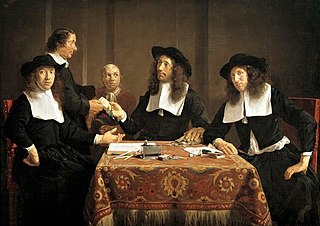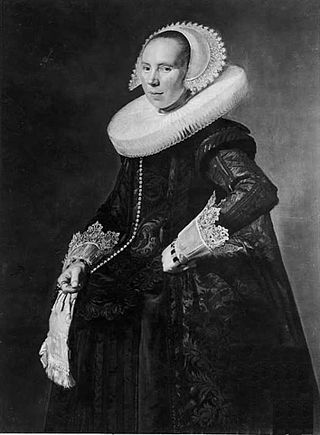
Frans Hals the Elder was a Dutch Golden Age painter. He lived and worked in Haarlem, a city in which the local authority of the day frowned on religious painting in places of worship but citizens liked to decorate their homes with works of art. Hals was highly sought after by wealthy burgher commissioners of individual, married-couple, family, and institutional-group portraits. He also painted tronies for the general market.

The Frans Hals Museum is a museum in the North Holland city of Haarlem, the Netherlands, founded in 1862, known as the Art Museum of Haarlem. Its collection is based on the city's own rich collection, built up from the 16th century onwards. The museum owns hundreds of paintings, including more than a dozen by Frans Hals, to whom the museum owes its name. The Frans Hals Museum has two historic locations in Haarlem city centre: the main location on Groot Heiligland and Location Hal on Grote Markt, composed of the adjacent 17th-century Vleeshal and 19th-century Verweyhal. On Groot Heiligland is the 17th-century Oudemannenhuis with regent's rooms. It houses the famous paintings by Frans Hals and other ancient, modern and contemporary art, as well as the museum café. Location Hal regularly hosts exhibitions of modern and contemporary art.

Willem van Heythuysen, was a Dutch cloth merchant and hofje founder in Haarlem and Weert. He is best known today for his portraits by Frans Hals, though he is remembered locally for his Hofje van Willem Heythuijsen bordering Haarlemmerhout park, which has been in operation for centuries.

The Proveniershuis is a hofje and former schutterij on the Grote Houtstraat in Haarlem, Netherlands.

Museum van de Geest was created in 2020 when Het Dolhuys, the national museum for psychiatry in Haarlem, the Netherlands, merged with the Outsider Art Museum from Amsterdam. Het Dolhuys had been founded in 2005 in the newly renovated former old-age home known as Schoterburcht, located just across the Schotersingel from the Staten Bolwerk park.

The Hofje van Codde en Beresteyn is a hofje in Haarlem, Netherlands. The current building is from 1968 and is located on the J. Cuyperstraat, which is named for the architect who designed the Cathedral of Saint Bavo next door, Joseph Cuypers. This hofje is the wealthiest hofje foundation in Haarlem with the most modern facilities for its inhabitants. Poor (devote) Catholic women of Haarlem 60 years and older are still welcome to live there for free.

The Banquet of the Officers of the St George Militia Company in 1616 refers to the first of several large schutterstukken painted by the Dutch painter Frans Hals for the St. George civic guard of Haarlem, and today is considered one of the main attractions of the Frans Hals Museum, Haarlem.

Banquet of the officers of the Calivermen Civic Guard, Haarlem formerly known as The Banquet of the Officers of the St Adrian Militia Company in 1627, refers to a schutterstuk painted by Frans Hals, in 1627, for the St. Adrian civic guard of Haarlem. Today it is considered one of the main attractions of the Frans Hals Museum, in Haarlem.

Isabella Coymans, was the Dutch wife of Stephanus Geraerdts best known for her portrait painted by Frans Hals.

Michiel de Wael, was a Dutch brewer and citizen of Haarlem, best known today for his portraits painted by Frans Hals. His grandfather, also a brewer, was one of the first Calvinists in the city and was involved in the Siege of Haarlem.

Portrait of Dorothea Berck is a 1644 painting by Frans Hals that is in the collection of the Baltimore Museum of Art. It depicts Dorothea Berck at age 51, the wife of the prosperous Haarlem merchant Joseph Coymans, whose portrait Hals also painted. Both paintings were executed on the occasion of their daughter Isabella's wedding, whose marriage pendants Hals also painted.

The Meagre Company, or The Company of Captain Reinier Reael and Lieutenant Cornelis Michielsz Blaeuw, refers to the only militia group portrait, or schutterstuk, painted by Frans Hals outside of Haarlem. Today the painting is in the collection of the Amsterdam Museum, on loan to the Rijksmuseum, where it is considered one of its main attractions of the Honor Gallery. Hals was unhappy about commuting to Amsterdam to work on the painting and, unlike his previous group portraits, was unable to deliver it on time. The sitters contracted Pieter Codde to finish the work.

The Lute Player is an oil-on-canvas painting from 1623 or 1624 now in the Louvre by the Haarlem painter Frans Hals, showing a smiling actor wearing a jester's costume and playing a lute.

The Regentesses of the Old Men's Almshouse Haarlem is a regents group portrait of four regentesses and their servant painted by Frans Hals, c. 1664, for the Oude Mannenhuis in Haarlem, the Netherlands. It forms a pendant with the Regents of the Old Men's Almshouse.

A regents group portrait, is a group portrait of the board of trustees, called regents or regentesses, of a charitable organization or guild. This type of group portrait was popular in Dutch Golden Age painting during the 17th century, and in the 18th century. They were intended to be hung in the regentenkamer, the regents' meeting room, or another prominent location in the institution.

Yonker Ramp and His Sweetheart is an oil-on-canvas painting by the Dutch Golden Age painter Frans Hals, painted in 1623 and now in the Metropolitan Museum of Art, New York City. The painting has also been titled as Young Man and Woman in an Inn or Portrait of Pieter Ramp.

Claes Duyst van Voorhout is an oil-on-canvas portrait painting by the Dutch Golden Age painter Frans Hals, painted in 1638 and now in the Metropolitan Museum of Art, New York City.

The Smoker is an oil-on-panel painting by the Dutch Golden Age painter Frans Hals, painted in 1626 and now in the Metropolitan Museum of Art, New York City.

Portrait of Cunera van Baersdorp is an oil-on-panel painting by the Dutch Golden Age painter Frans Hals, painted in 1625 and now in a private collection. It is considered a pendant portrait to the Portrait of a Man Standing, now identified as Cunera's husband Michiel de Wael.

Portrait of Stephan Geraedts, Husband of Isabella Coymans is a late oil on canvas painting by the Dutch Golden Age painter Frans Hals, made when the artist was about 70. The painting is one of a pendant pair of wedding portraits, now separated. Hals probably painted the present portrait, Stephanus Geraerdts', an alderman of Haarlem, which was designed to be on the left, and the accompanying portrait of his wife Isabella Coymans around 1650–1652, six or seven years after their marriage in 1644. Isabella's portrait is now in a private collection in Paris.




















